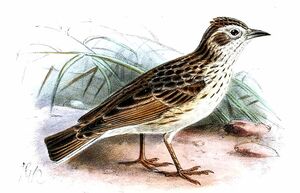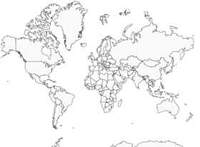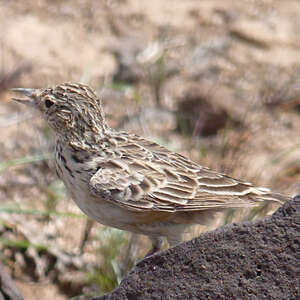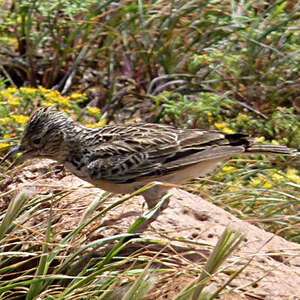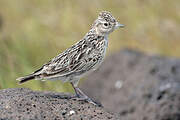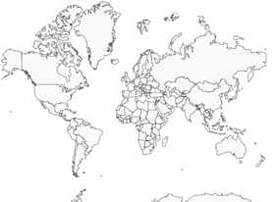Raso Lark
Alauda razae - Alouette de Razo
Identification
The Raso Lark can not be mistaken. It is the only representative of the family and, together with the Red-backed Shrike, one of the two only resident passerine species on the desolate islet of Razo. Its appearance and proportions make it look like a small Dunnock, but its feather pattern resembles more a small Grey-headed Skylark. Compared to this one, it is smaller in size, its wings and tail are shorter; its distinctly long and curved beak extends a more pronounced forehead. It also bristles the feathers of the crown, but in a lesser measure. The upper parts and the tertiaries have a dark brown center and are edged with beige in strong contrast, thus giving the bird a scaly appearance. The underside is white lightly washed with reddish. The chest is marked with clear blackish streaks. The eyes are surrounded by white glasses that give the bird's face a special look. A sexual dimorphism is noticeable at the light beak, which is longer and stronger in males.
Subspecific information monotypic species
Foreign names
- Alouette de Razo,
- Alondra de Razo,
- laverca-do-raso,
- Rasolerche,
- razo-pacsirta,
- Razoleeuwerik,
- Allodola di Razo,
- rasolärka,
- Rasolerke,
- škovránok ostrovný,
- skřivan kapverdský,
- Razo-lærke,
- rasonkiuru,
- alosa de l'illot Raso,
- Graslævirki,
- skowronek wyspowy,
- Rasu cīrulis,
- zelenortski škrjanec,
- Разаский малый жаворонок,
- ラザコヒバリ,
- 拉索云雀,
- rasolärka,
- 尼日雲雀,
Voice song and call
Habitat
The species is confined to the low volcanic plateaus with a minimum of vegetation, mainly in the southwest of the inhabited island and right by the sea. The rest is rugged and very arid. The favorable environment does not exceed 3 to 4 km² out of the 7 on the island. The ground is mainly bare, rocky or sandy, and the vegetation cover, composed of low succulents, is low. There is no fresh water other than rainwater, and this is a very restrictive factor for Raso Lark.
Behaviour character trait
The bird is not at all shy and it is easy to observe. The way it moves on the ground and its compact look while flying resemble a small lark. The species is gregarious like many other larks outside of their breeding season. As the favourable environment is limited, reproductive couples have adjacent territories, which does not seem to cause any problems. Then, one can see both partners wandering together looking for food. After breeding, family groups form.
Flight
The short and wide wings suit this sedentary bird which only performs short local flights. Its way of flying is somewhat like that of a Red-rumped Swallow. The territorial male uses it to carry out its nuptial flight which starts with a vertical ascent, continues with a 20-30m pause at altitude, and ends with a vertical descent again.
Dietfeeding habits
Its strong beak allows it to search for food in and on the ground. This probably consists of various invertebrates and seeds. We have also seen the Raso Lark ripping open herbaceous stems with its beak and consuming the contents, either pith or mining larvae.
Reproduction nesting
Nest building depends on the rains, which can be quite irregular. It is possible that there are two periods of breeding, one in the fall from September to November and the other in the spring from February to April. On a recent visit in early October, the birds were in full breed. The nest is made of herbaceous stems placed in a scrape at the foot of a rock or clump. Clutch size is 1-3 eggs. Nesting success has been estimated at less than 5%. This very low rate can be mainly attributed to predation by a large Tarentola gigas gecko, which is common on the island.
Geographic range
The Raso Lark, as its name suggests, is endemic to one of the islands of the Cape Verde archipelago, the island of Razo off the coast of Sao Nicolau. This extremely endemic nature is therefore a world record. This extremely limited distribution is obviously a factor that can be very negative in the specific dynamics.
Threats - protection
IUCN conservation status
concern
in the Wild
threatened
evaluated
Even though the species seems to be well adapted to its environment, due to its geographic isolation and the weakness of its population (estimated to be 200-250 individuals at the end of the 80s, but revised since then), its status is precarious. It was even classified Critically Endangered by the UICN, maybe due to initial lack of knowledge on its biology and ecology. It is now closely monitored. A good part of the birds are ringed, which will allow in the future to specify the parameters of its demography. Furthermore, the island is protected, which excludes a permanent human presence which could be detrimental. Remain the current climate uncertainties which could weigh even more in the future on this small paradise and its adapted hosts.
Sources of information
- IOC World Bird List (v15.1), Gill, F and D Donsker (Eds). 2025-12-07.
- Birds of the Atlantic Islands, Clarke Tony
- Guide encyclopédique des oiseaux du Paléarctique occidental, Mark Beaman, Steve Madge
Other sources of interest
 Specification sheet created on
28/07/2023 by Jean François
Specification sheet created on
28/07/2023 by Jean FrançoisTranslation by AI Oiseaux.net
© 1996-2025 Oiseaux.net
- Accipitriformes
- Aegotheliformes
- Anseriformes
- Apodiformes
- Apterygiformes
- Bucerotiformes
- Caprimulgiformes
- Cariamiformes
- Casuariiformes
- Charadriiformes
- Ciconiiformes
- Coliiformes
- Columbiformes
- Coraciiformes
- Cuculiformes
- Eurypygiformes
- Falconiformes
- Galliformes
- Gaviiformes
- Gruiformes
- Leptosomiformes
- Mesitornithiformes
- Musophagiformes
- Nyctibiiformes
- Opisthocomiformes
- Otidiformes
- Passeriformes
- Pelecaniformes
- Phaethontiformes
- Phoenicopteriformes
- Piciformes
- Podargiformes
- Podicipediformes
- Procellariiformes
- Psittaciformes
- Pterocliformes
- Rheiformes
- Sphenisciformes
- Steatornithiformes
- Strigiformes
- Struthioniformes
- Suliformes
- Tinamiformes
- Trogoniformes

